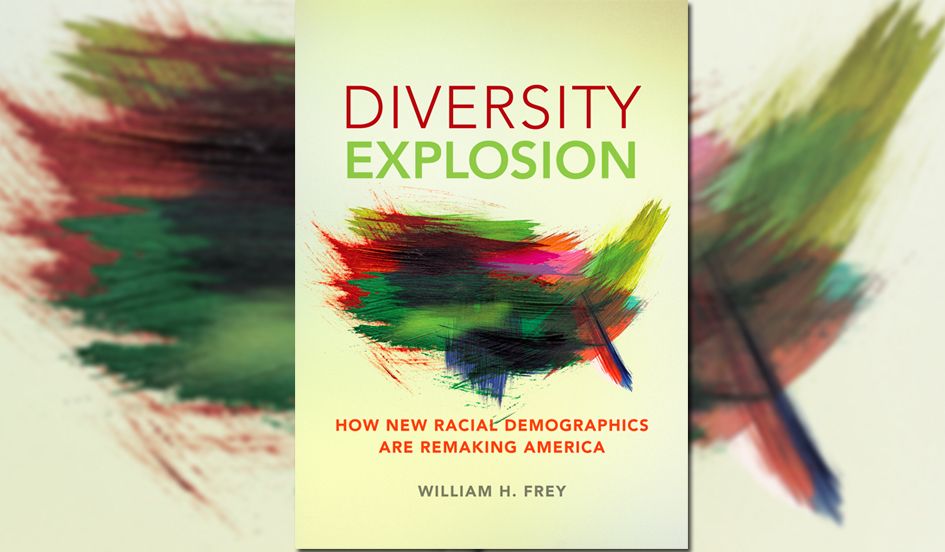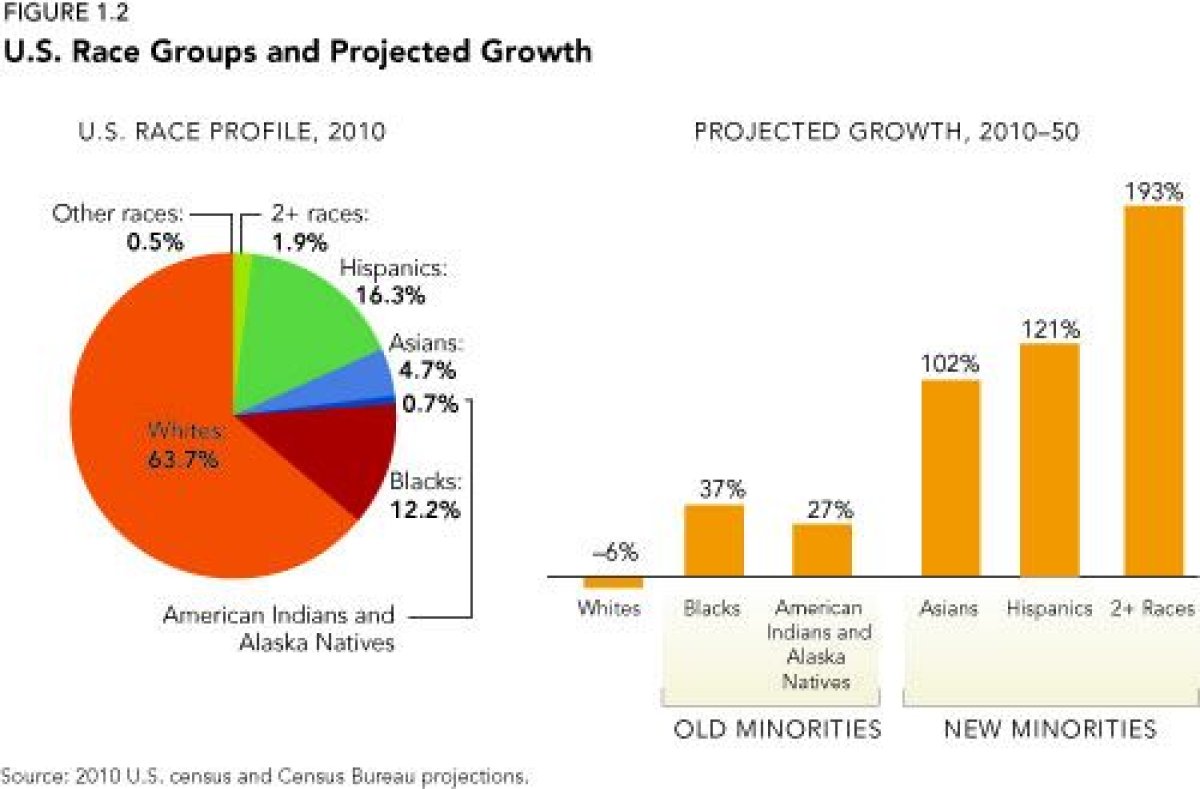
America reached an important milestone in 2011. That occurred when, for the first time in the history of the country, more minority babies than white babies were born in a year.
Soon, most children will be racial minorities: Hispanics, blacks, Asians, and other nonwhite races. And, in about three decades, whites will constitute a minority of all Americans (see chart, below).

This milestone signals the beginning of a transformation from the mostly white baby boom culture that dominated the nation during the last half of the twentieth century to the more globalized, multiracial country that the United States is becoming.
Certainly in the past, the specter of a "minority white" nation instilled fear among some Americans, and to some extent it continues to do so today—fear of change, fear of losing privileged status, or fear of unwanted groups in their communities. These fears were especially evident during the decades following World War II, when immigration was low and phrases such as "invasion," "blockbusting," and "white flight" were commonly used in the context of black-white segregation.
Such fears are evident today in the public backlashes that sometimes occur against more permissive immigration and voter registration laws.
Yet if demography is truly destiny, then these fears of a more racially diverse nation will almost certainly dissipate. In many communities, a broad spectrum of racial groups already is accepted by all, particularly among the highly diverse youth population.
Moreover, as my book Diversity Explosion: How New Racial Demographics are Remaking America illustrates, a growing diverse, globally connected minority population will be absolutely necessary to infuse the aging American labor force with vitality and to sustain populations in many parts of the country that are facing population declines. Rather than being feared, America's new diversity—poised to reinvigorate the country at a time when other developed nations are facing advanced aging and population loss—can be celebrated.
The sweep of diversity that has just begun to affect the nation is the theme of my book, which draws from my examination of the most recent U.S. census, census projections and related sources. As a demographer who has followed U.S. population trends for decades, even I was surprised by the sheer scope of racial change that came to light with the 2010 census.
The story that the data tell is not just more of the same. I am convinced that the United States is in the midst of a pivotal period ushering in extraordinary shifts in the nation's racial demographic makeup. If planned for properly, these demographic changes will allow the country to face the future with growth and vitality as it reinvents the classic American melting pot for a new era.
In my experiences speaking publicly and answering press inquiries, I have seen the intensity of Americans' questions and thoughts about issues surrounding race. After having absorbed these startling census results and their implications, I wanted to interpret and expound on the dramatic shifts that they illustrate so that a general audience of readers can appreciate their force, promise, and challenges.
Key among these changes are:
— the rapid growth of "new minorities": Hispanics, Asians, and increasingly multiracial populations.
During the next 40 years, each of these groups is expected to more than double (see chart below). New minorities have already become the major contributors to U.S. population gains. These new minorities—the products of recent immigration waves as well as the growing U.S.–born generations—contributed to more than three-quarters of the nation's population growth in the last decade. That trend will accelerate in the future.

— the sharply diminished growth and rapid aging of America's white population.
Due to white low immigration, reduced fertility and aging, the white population grew a tepid 1.2 percent in 2000–10. In roughly 10 years, the white population will begin a decline that will continue into the future. This decline will be most prominent among the younger populations. At the same time, the existing white population will age rapidly, as the large baby boom generation advances into seniorhood.
— black economic advances and migration reversals.
Now, more than a half-century after the civil rights movement began, a recognizable segment of blacks has entered the middle class while simultaneously reversing historic population shifts. The long-standing Great Migration of blacks out of the South has now turned into a wholesale evacuation from the North—to largely prosperous southern locales.
Blacks are abandoning cities for the suburbs, and black neighborhood segregation continues to decline. Although many blacks still suffer the effects of inequality and segregation is far from gone, the economic and residential environments for blacks have improved well beyond the highly discriminatory, ghettoized life that most experienced for much of the twentieth century.
— the shift toward a nation in which no racial group is the majority.
The shift toward "no majority" communities is already taking place as the constellation of racial minorities expands. In 2010, 22 of the nation's 100 largest metropolitan areas were minority white, up from just 14 in 2000 and 5 in 1990. Sometime after 2040, there will be no racial majority in the country.
This is hardly the America that large numbers of today's older and middle-aged adults grew up with in their neighborhoods, workplaces and civic lives. One implication of these shifts will be larger multiracial populations as multiracial marriages become far more commonplace.
The "diversity explosion" the country is now experiencing will bring significant changes in the attitudes of individuals, the practices of institutions and the nature of American politics. Racial change has never been easy, and more often than not it has been fraught with fear and conflict.
Yet for most of the nation's history, nonwhite racial groups have been a small minority. Partly because of that, blacks and other racial minorities were historically subjected to blatant discrimination, whether through Jim Crow laws, the Asian Exclusion Act, or any of the many other measures that denied racial minorities access to jobs, education, housing, financial resources, and basic rights of civic participation.
What will be different going forward is the sheer size of the minority population in the United States. It is arriving "just in time" as the aging white population begins to decline, bringing with it needed manpower and brain power and taking up residence in otherwise stagnating city and suburban housing markets.
Although whites are still considered the mainstream in the United States, that perception should eventually shift as more minority members assume positions of responsibility, exert more political clout, exercise their strength as consumers, and demonstrate their value in the labor force. As they become integral to the nation's success, their concerns will be taken seriously.
William H. Frey, senior fellow in the Brookings Institution Metropolitan Policy Program, is an internationally regarded demographer, known for his research on urban populations, migration, immigration, race, aging, political demographics and his expertise on the U.S. Census. He was the first to predict that 2011 would be the first year in which more minority babies than white were born.
Reprinted with permission from Diversity Explosion: How New Racial Demographics are Remaking America by William H. Frey (Brookings Press, 2014).
Uncommon Knowledge
Newsweek is committed to challenging conventional wisdom and finding connections in the search for common ground.
Newsweek is committed to challenging conventional wisdom and finding connections in the search for common ground.
About the writer
To read how Newsweek uses AI as a newsroom tool, Click here.








